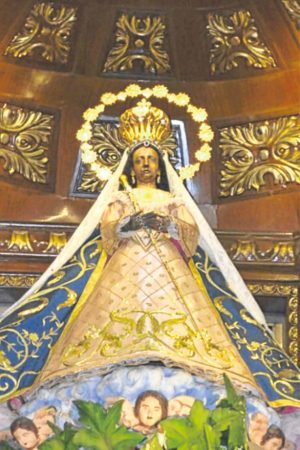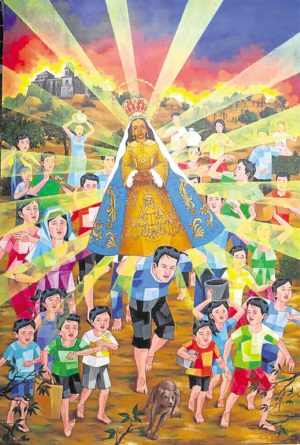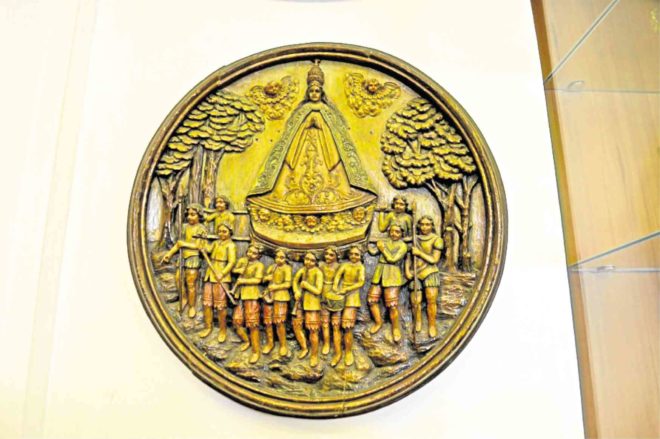
What used to be the quaint and simple space dividing the altar and the Camarin de la Virgen of the Nuestra Señora de la Paz y Buen Viaje inside the postwar Antipolo Church has been given a facelift and upgraded into a permanent exhibition area, showcasing the rich heritage of both the church and the nearly 400-year-old image of the Virgin of Antipolo.
Canonically crowned in 1926, the dark wooden image of the Virgin was brought in 1626 to the Philippines from Mexico by Governor General Niño de Tabora and was entrusted to the Jesuits.
Thirteen years later, it was enshrined at the original church of Antipolo which was built by the Jesuits from 1630 to the 1650s.
The image, particularly the face, suffered minor damage in the Chinese uprising of 1639-1640.
Attributed to a number of miracles and favors received among devotees, the Virgin was moved a number of times out of Antipolo to Manila, Cavite, and back to Manila in various circumstances.
It was made the patroness of the galleons and Spanish ships in the 17th century since their safe voyages were credited to the image.
The image was also credited for the withdrawal of the Dutch troops attacking Cavite in 1646.
In 1853, Governor Sabiniano Manrique decreed that the image of the Inmaculada Concepcion be also known as the Nuestra Señora de la Paz y Buen Viaje while in 1926 it was canonically crowned in a ceremony in Manila.
Housed at the Antipolo Cathedral, the image and its crown were saved from the American bombardment during World War II after it was evacuated by residents, led by the sacristan mayor Procopio “Mang Copio” Angeles to Sitio Colaique, then to Angono, Taytay, Cainta and Pasig, where representatives from the Manila archdiocese took the image, stored it at the Ocampo residence in Quiapo, and eventually in the Quiapo Church.
In 1945, it was returned to the Antipolo Church (then already in ruins) via an American amphibian tank decorated with flowers.
Artifacts
Not much was left of the 17th-century church of Antipolo, so that authorities decided to demolish the ruins and construct a new structure.
Today, the modern circular church of Antipolo is a popular pilgrimage site, particularly during Holy Week. It is now the cathedral of the bishop of the Diocese of Antipolo.

What was left from the old church were two bells, four larger than life sculptures of Santa Ines, San Francisco Javier, Santa Barbara, and San Ignacio, which were later stored inside the old mortuary chapel of the town’s cemetery but were eventually brought back to the church. Other remnants were the image of San Ignacio de Loyola, and two wooden reliefs that used to adorn the walls.
The San Ignacio de Loyola image is now at the Jesuit Novitiate in Novaliches, while the two reliefs are now part of the San Agustin Museum collection.
The four large molave sculptures are now part of the newly-opened exhibition area.
Also part of the exhibit are a number of religious images, the ornately decorated dresses and crowns of the Virgin.
The dresses totals to more than 400, with the oldest dating to the 1950s. Those exhibited are changed every quarter.
One of those is a piece specially made by renowned fashion designer Pitoy Moreno which is displayed in a small room together with two other special pieces.
That room also houses the pilgrim image of the Virgin of Antipolo.
Aside from these, four impressive rounded wooden polychromed reliefs from the post-war church also adorn the exhibition area.
Church art
The exhibit is the brainchild of the cathedral’s rector, Fr. Nante Tolentino.
Proud of his Angono heritage, Fr. Tolentino commissioned Angono artist Nani Reyes to do three large format paintings depicting important events associated with the Virgin.
An artist with a unique cubist style marked by his use of bright hues, Reyes painted the “Ang Pagpapakita ng Mahal na Ina sa Puno ng Tipolo,” “Ang Mahal na Birhen ng Antipolo at ang Sitio Hinapao,” and “Ang Paglikas sa Mahal na Ina patungong Sitio Colaique.”
Two of these works now hang at the exhibit area while the third is displayed at the Gospel side chapel of the church
Reyes’s artworks, according to Fr. Tolentino, will be used as models of the stained glass panels which will adorn the church’s sacristy, the second time for him after his Manila Cathedral stained-glass project last year. –CONTRIBUTED













































